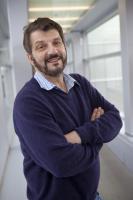2013 Neff Public Lecture
David A. Weitz
Dripping, Jetting, Drops and Wetting: The Magic of Microfluidics
Mallinckrodt Professor of Physics, Harvard University

Monday, April 1, 2013
4:30 p.m.
Leadership Studies, McVay Family Town Hall
Just as microelectronics have revolutionized the way we deal with information, so have microfluidic devices revolutionized the way we control fluids. These devices can also be used to control drops of one fluid in a second fluid. Using the exquisite control afforded by microfluidic devices, such drops have a myriad of uses and potential. For example, these drops can be used to encapsulate delicate or valuable materials and protect these from a harsh environment; at the same time, the drops can be very finely tuned to enable highly controllable release of the encapsulated active ingredient. Such structures have great promise for encapsulation and release of active ingredients for applications ranging from drug delivery to food. However, making materials of this type using microfluidic devices entails making them one drop at a time, and making practical quantities of materials presents challenges for scaling up the production of materials. Once this is done, these drops can be used to create numerous interesting materials. The exquisite control of the drops in microfluidic devices can also be harnessed to create a new class of reaction vessel that enables very high speed experimentation using truly minute quantities of fluids. This enables a range of new biological experiments to be undertaken and provides the basis for new technologies with importance in healthcare and diagnostics. This wide range of uses of microfluidic devices will be described in this talk, and examples of each use will be given.